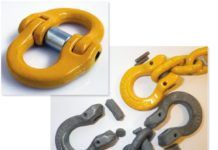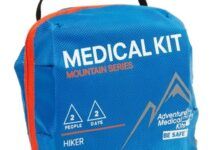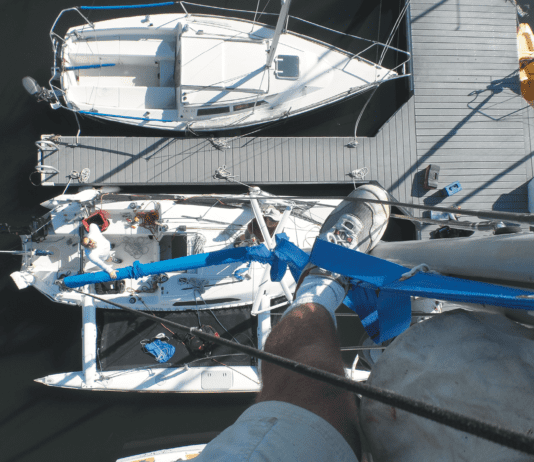Winter Projects – Tip #1
With winter approaching, its time to start your list of cold-weather projects and purchases. Remember: If you will be unstopping your masts this winter, and plan on buying new sails, be sure to take the measurements that your sailmaker will needs while the mast is still up.
The Minimum Sail Inventory for Cruising
Most of us make lists of things we'd like to add to our boats. Sails, it often seem, take a second seat to this other great gear, especially the latest electronics. By filling the gap in the sail inventory (for instance, buying a 130%genoa to add to the working jib and #1 genoa headsail inventory) can make all the difference between an enjoyable sail and one in which the boat just won't move because the right combination of sails can't be found. Even if you have roller furling and think your one headsail can do it all, that's not really the case when cruising.
The well-found cruising boat should carry sails for all types of weather, ranging from ghosting conditions to full-blown gales. Of course, much of the inventory will apply to those middle and more normal conditions. But shortchanging yourself by skipping storm sails or drifters means endangering the boat and crew at worst and subjecting them to excessive heel or irritating slatting at least.
The following are suggested minimum sail inventories for sloops, cutters, ketches, and yawls, including optional sails.
Sloop with single headsail:
-Mainsail Working jib
-No. 1 genoa (150%)
-No. 2 genoa (110% to 130%)
-Drifter, reacher or cruising spinnaker
-Trysail
-Storm jib
Optional:
-No. 2 jib
-Second mainsail
Note: a genoa designated as #1 or #2 does not refer to a specific percentage of foretriangle size (the LP measurement, which is a perpendicular from the luff intersecting the clew, is used in determining 130%, 150%, etc.). Rather, #1 or #2 refers to the largest headsail on board, next largest, and so on.
Cutter and double-headsail sloops:
-Mainsail
-Yankee jib
-Staysail with reef points
-Trysail
-Storm jib
-Drifter, reacher, or cruising spinnaker
Optional:
-No. 1 Yankee jib
-No. 3 Yankee jib
-Small or storm staysail
Ketch or Yawl:
-Mainsail Mizzen working jib
-No. 1 genoa (150%)
-No. 2 genoa (110% to 130%)
-Drifter, reacher, or cruising spinnaker
-Trysail Storm jib
Optional:
-No. 2 jib
-Mizzen staysail
To get additional information and tips on upgrading your boats rig and sails, purchase Spurr's Guide to Upgrading Your Cruising Sailboat today!
Winterizing Your Sailboat – Tip #1
While a haul out gives you opportunity for some repair, maintenance and upgrade work, it's important to follow some winterizing procedures to avoid problems in the spring. Today's tip focuses on your inboard engine and should be performed after your haul out.
Inboard Engines:
All salt water must be flushed from the engine. An easy method is to open the sea water strainer, remove the basket and put a garden hose into the bowl. Start the engine, and adjust the flow of fresh water. The seacock to the strainer must be closed to create suction. After operating temperature has been reached, run for an additional ten minutes.
With the engine running, remove the hose and pour antifreeze into the water strainer. When the exhaust becomes a consistent color, all the water has been displaced. Shut the engine down and top-up the strainer with antifreeze. Put the top back on the strainer and open the seacock.
A note on choosing antifreeze: Although eco-friendly propylene glycol (PG) is usually recommended because of its low toxicity, this chemical can harm neoprene, a material commonly used in valves, seals, and impellers. Ethylene glycol (EG), which PG was meant to replace, is kinder to these components, but users need to take care to handle and dispose of it properly. In any case, never use EG in potable water systems.
Change the engine oil and filter. Change the fuel filter if required. Inspect the gear box and replace oil if required. (Note: ALWAYS remove the foil seal on engine oil bottles COMPLETELY. Pushing it in like a flap increases the odds it will break loose and get poured into the valve cover.)
If the stuffing box is a dripless PYI type, loosen the collar and let the bellows expand, as per the instructions. Otherwise, inspect the traditional stuffing box packing for signs of wear on the shaft. Test the antifreeze in freshwater cooled engines. Inspect the water pump impeller, anti-siphon vents, and engine control cables - particularly the swivel ends. Inspect the cables, chains, and pulleys on pedestal steering systems, or else check the fluid in hydraulic steering systems. Inspect the packing gland on the rudder. Make certain all seacocks are sound.
For more important tips on the maintenance of your engine, purchase Beth Leonard's The Voyager's Handbook, 2nd edition today!
Winterizing Your Sailboat – Tip #2
In the colder climates, its time to start thinking about hauling out and winterizing your boat. While a haul out gives you opportunity for some repair, maintenance and upgrade work, its important to follow some winterizing procedures to avoid problems in the spring. Todays tip focuses on your outboard motor and should be performed after your haul out.
Outboard motors:
Flush with fresh water for 15 minutes. To be on the safe side, run a half gallon of non-toxic antifreeze through the system. Four stroke outboards will need an oil and filter change. For all engine types, remove the spark plugs and spray a fogging oil into the cylinders. Replace the plugs and turn the engine over but do not run it. Drain the lower unit and replace lube oil. Even when dirty, the oil should be translucent. If it looks like dirty mayonnaise, water is leaking through the shaft seals. Have them replaced.
For more important tips on the maintenance of your engine, purchase Beth Leonard's The Voyager's Handbook, 2nd edition today!
Winterizing Your Sailboat – Tip #3
In the colder climates, its time to start thinking about hauling out and winterizing your boat. While a haul out gives you opportunity for some repair, maintenance and upgrade work, its important to follow some winterizing procedures to avoid problems in the spring. Todays tip focuses on your fresh water systems and should be performed after your haul out.
Fresh water systems:
Drain water tanks
Add a few gallons of non-toxic antifreeze to the empty tanks and pump the fluid through each faucet until the color is pink. Dont forget the deck wash down pump, cockpit shower, shower sump, and electric head. Salt water deck washes will have a dedicated pump which some electric heads share. On stand alone pumps like these, remove the intake hose and suck non-toxic antifreeze through system. ALWAYS properly reconnect hoses when finished.
Toilets: Fill the bowl with a gallon of non-toxic antifreeze and pump dry. If the system has a direct discharge valve, pump a half gallon overboard, then a half gallon into the holding tank.
Holding tanks: Pour a gallon of non-toxic antifreeze into the tank from deck. Operate the overboard discharge pump until non-toxic antifreeze is present.
Pour non-toxic antifreeze into the bilge and operate all pumps.
For more than 1,000 tips, suggestions, evaluations, and nuggets of hard-won advice from more than 300 seasoned veterans, purchase Sailors' Secrets: Advice from the Masters today!
Winterizing Your Sailboat – Tip #4
In the colder climates, its time to start thinking about hauling out and winterizing your boat. While a haul out gives you opportunity for some repair, maintenance and upgrade work, its important to follow some winterizing procedures to avoid problems in the spring. Todays tip focuses on your mast and should be performed after your haul out.
Mast Storage
Spray sails with fresh water to remove salt crystals. Lubricate the turnbuckles, even the mast remains in the boat this is a good idea. Inspect halyards and standing rigging. Do not wrap a mast tightly in plastic to keep it dry. It will promote corrosion. Draping plastic over the mast is OK if air can get under it. Do not lay mast on carpeting, or any material that will absorb water.
For more than 1,000 tips, suggestions, evaluations, and nuggets of hard-won advice from more than 300 seasoned veterans, purchase Sailors' Secrets: Advice from the Masters today!
Winterizing Your Sailboat – Tip #5
For many, its time to think about winterizing. It is far better to perform most routine maintenance at the end of the season when laying up rather than when recommissioning for the next season.
Spars and Standing Rigging.
Wooden spars and spreaders: Wash and inspect closely for any signs of rot (e.g. softening or discoloration), especially on spreaders and around fasteners and exit holes. Seal bare spots even if you are not varnishing or painting at this time.
Aluminum spars: Wash and inspect for signs of corrosion, distortion of mast walls (especially around spreader sockets), crazing of anodizing, and hairline cracks (especially around welds and cutouts). Remove and grease any fasteners that must be prevented from freezing up. Wax the spar before storing.
Carbon fiber spars: Clean and inspect all attachment points for signs of delamination or other damage.
All spars: Withdraw mast tang bolts and check for crevice corrosion. Remove boots or covers from spreader tips. Remove head box sheaves and inspect shafts and sheaves. Lubricate and replace. Remove turnbuckle boots, tape, etc. Undo all turnbuckles, clean, inspect, and grease. Pay close attention to clevis pins; when replacing, tape over the ends of cotter pins (split pins). Inspect swages for hairline cracks. Wash all rigging. Do not store stainless against aluminum spars. If stored outside, do not rest on water absorbent materials.
For more winterizing procedures, as well as thousands of other repair and maintenance tips, purchase Nigel Calders Boatowner's Mechanical and Electrical Manual today!
Wood Finishing – Tip #1
Organize projects according to the weather, and youre guaranteed to finish them within your lifetime.
In the hierarchy of organizing projects around the weather, start first with seasonal organization:
SPRING - when its frequently raining . . . is the best time for exterior bleaching, because the air is cool and moist. Sometimes you get lucky and can get started on other exteriror projects like painting and varnishing (depending on your latitude). Its a lovely time to varnish interiors, especially cabin soles.
SUMMER - when its often sunny. . .is when its easiest to bank on completion of exterior work of all kinds, which is why so many people set aside entire blocks of vacation time in July to work on their boats. This accounts for the high vacancy rate in the cruising marinas during that month.
FALL - when mother nature is still fooling herself . . . is a good time to wrap up, as quickly as possible, any uncompleted exterior finishing business, and focus on projects belowdecks that require strong ventilation and open hatches (wholesale varnishing and oiling, for example).
WINTER - when the mercury dips below 45 F . . . is the time to take projects to the shop or confine interior projects to light oiling, or the perfect time to just curl up with a nice book.
For more information and advice on the products and methods to use to create stunning brightwork, purchase Rebecca Wittmans The Brightwork Companion today!
Packing the Spinnaker – Tip #1
Packing the Spinnaker in a Chute or a Pouch
Chute
It is important that the spinnaker is packed correctly in its chute or pouch, bag, or locker before the boat goes afloat. It must be packed without twists, or it will be difficult for the crew to set the sail when it is hoisted.
Chute Packing Procedure
Before you go afloat, attach the halyard, sheets, and downhaul to the spinnaker and hoist the sail to make sure it not twisted. Pull on the downhaul as you lower the spinnaker so that the sail is drawn into the chute. Keep pulling steadily until all the spinnaker has disappeared completely into the mouth of the chute. Take all the slack out of the halyard and the sheets and cleat them.
Pouch Packing Procedure
If possible, the best way to do this is to hoist the sail while the boat is ashore or moored and then lower it into the pouch or locker. To do so, pull down one luff and pack it into the pouch then gather in the rest of the sail until the three corners lie on top of the sail bundle.
Steve Sleights The Complete Sailing Manual, covers every aspect of sailing and seamanship, whatever your level of experience. Full of hundreds of pages of tips and advice like the information above, The Complete Sailing Manual is sure to help every sailor. Purchase it today!
Painting Your Own Deck – Tip #1 (NEEDS RE-APPROVAL – COPY’S OLD)
Painting Your Own Deck
Is this DIY job biting off more than you can chew? Practical Sailor answers a readers question on this topic.
My wife and I have owned our boat since 1985. We now keep it in the British Virgin Islands, where the Caribbean sun is tough on finished wood and fiberglass.
The reason I am writing you is to get your true feeling about novices handpainting our decks. We want to keep the nonskid and the white border design we currently have. The decks were Awlgripped by the factory in 1992, but this has turned chalky and shows tremendous wear.
Is it feasible to try such a project? Or should I just pony up the money to have it done? We have time and plenty of elbow grease and a willingness to try.
Amateur do-it-yourself nonskid painting is a very feasible project to undertake, however, the smooth, glossy waterways, vertical cabin sides, cockpit-well sides, and other transition areas are another story.
It has been our experience that an amateur can sand, clean, tape, and roll on a one- or two-part polyurethane nonskid paint and achieve very respectable results. We recommend using products from a single manufacturer to insure chemical compatibility, and we underscore the importance of carefully following product directions.
With glossy vertical surfaces, the DIY challenge rises significantly. Those looking for a finish like that achieved by the pros had best be very proficient at the craft. Spray application is the preferred painting method, and only the most serious DIYer is ready to tackle the health, safety, and technical challenges associated with this job. Deft handling of a sprayed coating is a precarious balance between too little flow resulting in orange peel, and too much flow resulting in sags. Between the two resides a slick, highly reflective surface that gains the awe of every onlooker.
If a less-dazzling finish is acceptable, then theres hope for the brush-and-roller wielding DIYer. First, carefully prepare the surface, and when applying an LPU paint by roller and brush, remember "less is best."
A slower reducer allows the paint to flow and makes brush and roller marks disappear. Multiple light coats with scuff sanding in between works best.
Your Alden has a certain market value based upon a specific level of fit and finish, a less than first-rate finish wont hurt the vessels seaworthiness, but it could impact its resale value. Add to this the significant investment in time and effort a DIY approach requires, and the myth "all it cost was the price of materials" tends to disappear. We are advocates of the hands-on approach but also recognize the implications of biting off more than you can chew.
For more advice on refinishing your deck, purchase Don Caseys Sailboat Refinishing from Practical Sailor today!
Plumbing – Tip #1
From the freshwater supply to fuel and wastewater, knowing the level of all tanks is essential for comfortable and safe sailing. Several tank-monitor manufacturers now refer to three types of tanks: fresh for drinkable water, gray for drain water from sinks and showers, and black for wastewater holding tanks from toilets. Its the black water were concerned about here.
Whether youre starting out on a Sunday daysail or a two-week inland cruise, one of your checklist items should always be Check the tanks-especially the holding tank. Knowing the holding tank level does more than help you avoid an uncomfortable situation when a guest goes to pump the head. It can keep you from running afoul of the law.
Federal law mandates that all boats with permanent toilets have either an on-board treatment system or a holding tank to store wastewater. Many states have inland lakes and coastal areas that are designated as No Discharge Zones (NDZ), areas that prohibit discharge of untreated waste into the water. Unless you are far offshore or in coastal waters where direct discharge is legal, suddenly discovering the holding tank is full is surefire way to ruin a sail.
Most older and smaller boats do not have level gauges on any tanks. A captain just knew about how full his tanks were or could judge the level by simply thumping the tank with his knuckles. Occasionally, if the tanks had inspection ports, a visual check with a flashlight or inserting a dipstick was sufficient.
Today, there are several options for measuring tank levels, starting with the simple internal float gauge and progressing to sophisticated ultrasonic capacitance or sonar internal probes. Not all holding tank gauges work as well as they claim-and when they fail, the consequences arent pretty. Fortunately, Practical Sailor has just wrapped up extensive testing of marine plumbing components. Weve picked the winners and losers in each category, including holding tank sensor, and offer tips on installation and maintenance.
For a complete review of holding tanks and the gauges and sensors available to measure their levels, purchase and download the Practical Sailor ebook, Plumbing and Odor Control.









































